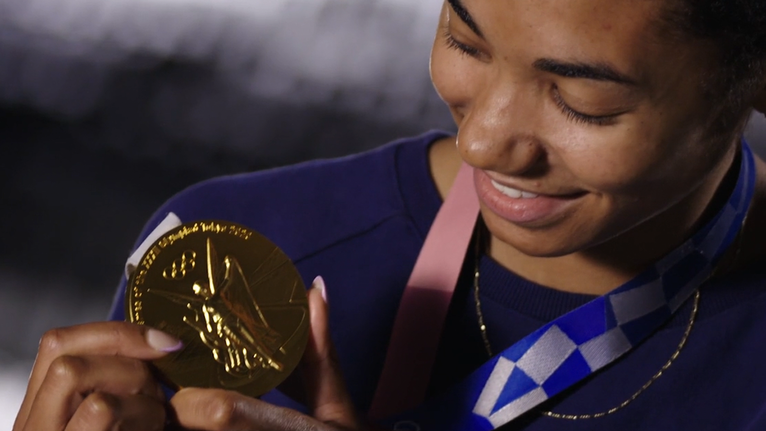World-Class Care for World-Class Athletes
The same surgery that got Tommy John back on the mound would also restore Jordan’s elbow and continue her journey toward Olympic glory.
“Going into surgery, I knew I had the best trainers and physicians taking care of me,” Jordan said. “Dr. Colosimo is very honest and upfront about the process and what it’s going to feel like. I really appreciated that and knew I was in good hands.”
With a successful surgery completed, Jordan was ready to recover and focus on getting back on the court.
“When you come back from an injury and you’re really uncertain about things, having those people who genuinely care and know what they’re doing, it really eases your mind as an athlete,” Jordan said.
“The relationship we have with UC Health is critical,” Coach Alvey said. “The presence of UC Health around our building on a daily basis is critical for us to keep our athletes healthy.”
“It’s so key at the college level because you have direct communication with the coaches, athletic trainers, physical therapists and the physicians,” Dr. Colosimo said. “We fortunately, at the University of Cincinnati, have probably the best athletic trainers and physical therapists in the country who were responsible for her rehabilitation.”
Coach Alvey and Jordan worked closely with Dr. Colosimo and the UC Health team to bring her back stronger than she was before, which at times meant setting the right pace for rehab.
“Jordan is one of those really, really special athletes who just stands out, never really complains and fights through,” Dr. Colosimo said. “She’s extremely aggressive and really tried to push it and push it, and we almost had to hold her back to get her where she wanted to be.”
“The worst part was trying to gain my range of motion and strength back slowly, then reintroducing volleyball to all of that,” Jordan said. “I really think of it as a blessing now to have that time to slow down and think, ‘You know, I have a few more years left of my college career. What do I want to make of that?’”
The extra year at UC would give Jordan an opportunity to fine-tune her skills as she hoped to move to the professional level.
“We slowly progressed her back in and took an international trip where you’re playing against older, more experienced teams,” Coach Alvey said. “That’s the first look that we got at her, and we knew she’d be just fine.”
Going for Gold
What Jordan ended up building for herself after her surgery and recovery was one of the most storied careers in the history of collegiate and Olympic volleyball.
The 6’4” right aide and outside hitter broke the UC Bearcats’ record for most kills in a single game. In volleyball, a “kill” is when an offensive attack is unreturnable by the opponent and results in a point for the offense. She is the sixth player in NCAA history to record 50 kills in a single game and finished her college career ranked seventh in all-time career kills in NCAA history. She’s No. 1 in NCAA history in the modern rally scoring era.
In 2019, she would be unanimously named American Athletic Conference Player of the Year. Then she would get the ultimate call: to represent the U.S. at the Olympics.
“So, many things have to align to have that opportunity,” Coach Alvey said. “To be the first-ever gold medalist in a sport you are incredibly strong in, it’s something no one can ever take away from you, no matter what happens for the rest of your career.”
“Getting to the Olympics by itself is such an amazing accomplishment, but the coolest part was walking around the Olympic Village and seeing all these athletes that have been through similar things,” Thomson said. “There’s so much struggle, time, effort, energy and goal setting that goes into it. You feel this really intense bond to these people who you might not even talk to.”
One person she did talk with while she in Tokyo was Dr. Colosimo, who continued to cheer her on stateside.
“One of the most rewarding things I’ve done for 30 years is to turn on the TV and to see one of my athletes on the field, whether it’s the NFL or Major League Baseball, or Jordan Thompson who’s winning the gold medal in volleyball,” Dr. Colosimo said. “Jordan was delightful. It’s been an honor getting to know her and absolutely a thrill to watch her win the gold medal.”
“I would say for anybody considering getting care at UC Health, you’re in good hands,” Jordan said. “That’s the most reassuring thing.”




